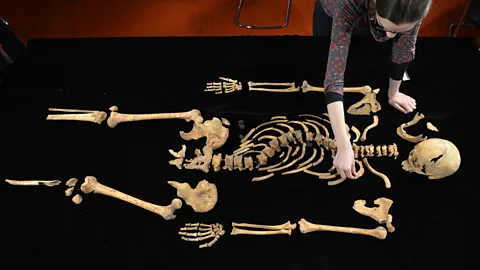
The former manufacturing city of Leicester is capitalising on the recent discovery of Richard III’s skeleton.
Move over Buckingham
Palace, there’s a new royal destination in town – a car park in Leicester,
about 100 miles north of London.
A small rectangle of tarmac in the centre
of a former manufacturing city might not fit in with the normal template of
regal attractions. But since early February, when Leicester University
researchers announced that they had found the
skeleton of King Richard III during an archaeological dig, Leicester
has been besieged with visitors hoping to get a glimpse of the royal bones.
Richard III, the last Plantagenet King of
England, was killed in battle by the armies of rival noble Henry Tudor at the Battle of Bosworth, which
took place in a field just outside Leicester in 1485. One of the most
controversial kings in British history, Richard III was demonised by
Shakespeare as a murderous usurper with a hunchback.
Historians were unsure as to what happened
to the king’s body after the battle, with some suggesting it was tossed into
the River Soar, which runs through Leicester’s Old Town. But others were
adamant the body had been buried in what was then the chapel of the Greyfriars
monastery. Over the centuries, the location of the monastery was eventually lost,
until an archaeological dig in the car park uncovered some of the church’s foundation,
a few bits of a wall and a skeleton with a twisted spine. Subsequent DNA
testing confirmed that the skeleton was that of the missing king.
As to be expected, Leicester is hoping to
capitalise on the international attention brought on by the royal discovery. On 8 February, an exhibition entitled Leicester’s
Search for a King opened in the 14th-century Guildhall,
which stands across the road from the parking lot, drawing in more than 1,000
visitors on its first day. The exhibition, which will be open for at least six
months, traces the story of Richard’s short reign (he was only king from 1483 to
1485), as well as the archaeological and scientific procedures that led to the discovery
of his skeleton. Interactive exhibitions allow visitors to take a closer look
at a replica of the skull and bones, including the injuries to his skull (and
buttocks) that scientists said led to the king’s demise.
A self-guided
walking tour has also been launched, highlighting the city sites connected
to the king. The mile-long route takes in Bow Bridge,
which is decorated with Richard’s coat of arms and features a
white boar. Richard’s army would have ridden across the bridge in
the morning of the battle, and his body would have crossed the bridge again when
it was taken back to the city that evening. Nearby is Castle Park,
where a statue of Richard stands in front of the ruins of the Norman-era Leicester
Castle. The tour ends at Leicester Cathedral, where
it is thought the king’s body will be reburied next year.
As for that famous car park, it is
currently out of bounds due to its continued use by municipal staff parking. The
trench itself is just visible from the gates, covered with a windowed white tent.
There are plans to convert an adjacent former school into a permanent visitor
centre, which will include access to the trench. Until then, there are occasional
guided tours of the site.
Correction: A previous version of this
article incorrectly stated the date of the Battle of Bosworth. This has been fixed.



